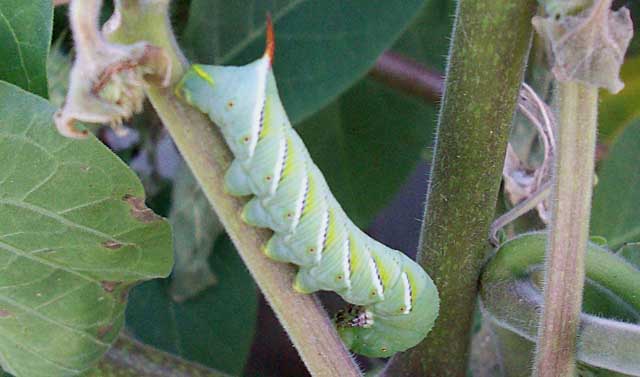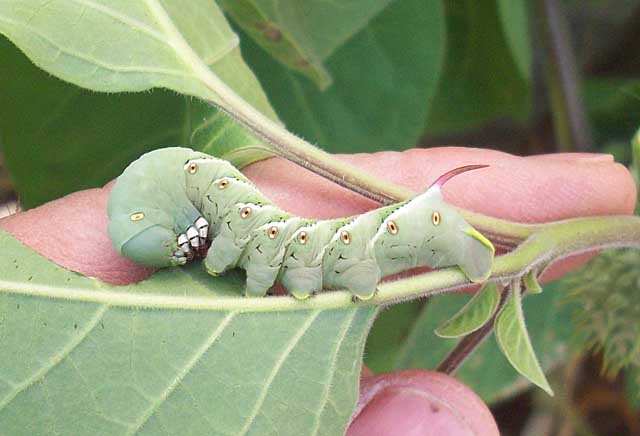Manduca sexta sexta
man-DOO-kuhmm SEX-tuh
Butler, 1877
The Carolina Sphinx

Manduca sexta sexta, fifth instar on moonflower (Datura innoxia), London, Ontario,
September 1, 2008, courtesy of Jack P. Brooks.
This site has been created by
Bill Oehlke at oehlkew@islandtelecom.com
Comments, suggestions and/or additional information are welcomed by Bill.
TAXONOMY:
Family: Sphingidae, Latreille, 1802
Subfamily: Sphinginae, Latreille, [1802]
Tribe: Sphingini, Latreille, 1802
Genus: Manduca Hubner, 1807 ...........
Species: sexta sexta Butler, 1877
|
MIDI MUSIC
.....It's a Wonderful World.....
copyright C. Odenkirk
ON.OFF
<bgsound src="world.mid" LOOP=FOREVER>
|
Manduca sexta is an irregular migrant to southern Ontario. It may become more common if winters become progressively warmer.
Jack writes, September, 1, 2008, "I cannot positively identify this caterpillar and I'm hoping you can. I found it today on my
Datura innoxia, plant. I think it might be a type of Manduca quinquemaculatus moth. I'm a little concerned for it, because I live in London, Ontario,
and do not know the cycle of this magnificent critter. I don't know if it will do all its thing before the frost and hopefully it'll go South and come back next year."
I replied, "That is a Manduca sexta larva, a close relative of Manduca quinquemaculatus. Note the red horn, typical of sexta.
Quinquemaculatus is similar but has a black horn.
"It is unusual for sexta to be so far north, but they have been seen in southern Ontario before. Caterpillar will tunnel underground when it is done feeding and
will pupate in a subterranean chamber and emerge
in three to four weeks (unlikely) or will more likely spend the winter underground in a dormant stage and then emerge as adult moth in late spring - early summer.
I would like permission to post your larva image with credit to you on the Ontario page?"
Jack responds, September 2, 2008, "I'd be happy if you posted that picture, and today I found another one. I have to tell you all of this story now. My Datura plant was
getting too big, so I pulled a lot of them out by the roots and put them in my trailer to dispose of later, but, when I started to clean them out, I found the
one, and today I went out to clean the rest out. While watching for these magnificent critters, I found another one. Now those Datura were pretty dry in my
trailer, because they've been in there for about a week or more and so what I did was move the twigs or branches that they were attached to back to the
main plant and just wedged them in so they'd hopefully move off onto the live plant.
I went out this morning to check and the one I placed there yesterday is still sitting in the same place. Is
there anything I can do, and do you want me to take a picture of both of them together?"
"I have posted a link to your image from the Ontario page at
http://www.silkmoths.bizland.com/SphOntario.htm
Link is in the sightings list and also from the Manduca sexta species file.
It would be great to get picture of them together."
Jack took his camera on a hunt and writes, "After I wrote you the last email, I went out in the yard to photograph the two of them together,
and the one I just put out there is nowhere to be found. It must be hiding somewhere and may be territorial. I don't know that much about them as I just discovered them,
but believe me I'll be doing my research now, how exciting. Anyway, while I was out looking for the other one,
I found this one and it appears much more mature than the other two."

Manduca sexta sexta, fifth instar on moonflower (Datura innoxia), London, Ontario,
September 2, 2008, courtesy of Jack P. Brooks.
Use your browser "Back" button to return to the previous page.

